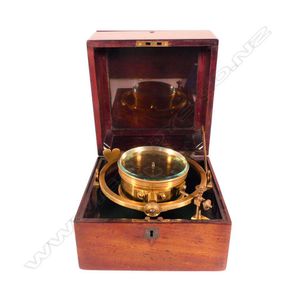Early Victorian Ship's Chronometer by Robert Roskell of Liverpool
A quality early Victorian mahogany cased ship's chronometer by Robert Roskell of Liverpool, numbered 193/32826, brass cased in gimble mount, the brass dial named, with Roman numerals and subsidiary seconds dial, the polished mahogany case with recessed brass handles. The dial diameter 12.3 cm, small flake chip to glass. Apparently working. c.1825-40. Note: Roskell began in business in Liverpool in 1805, making chronometers and other horological instruments. In the fractional serial number, the first number is that of the chronometer, while the second is that of all Roskell instruments.
You must be a subscriber, and be logged in to view price and dealer details.
Subscribe Now to view actual auction price for this item
When you subscribe, you have the option of setting the currency in which to display prices to $Au, $US, $NZ or Stg.
This item has been sold, and the description, image and price are for reference purposes only.
- Victorian Period - The Victorian period of furniture and decorative arts design covers the reign of Queen Victoria from 1837 to 1901. There was not one dominant style of furniture in the Victorian period. Designers used and modified many historical styles such as Gothic, Tudor, Elizabethan, English Rococo, Neoclassical and others, although use of some styles, such as English Rococo and Gothic tended to dominate the furniture manufacture of the period.
The Victorian period was preceded by the Regency and William IV periods, and followed by the Edwardian period, named for Edward VII (1841 ? 1910) who was King of the United Kingdom and the British Dominions and Emperor of India for the brief period from 1901 until his death in 1910. - Hunt & Roskell - Hunt & Roskell, were a firm of manufacturing and retail jewellers and silversmiths, founded in 1843 by Robert Roskell a famous pocket watch maker from Liverpool, and John Samuel Hunt who had previously been in partnership with silversmith Paul Storr, trading Storr & Co. (1819-22), Storr & Mortimer (1822-38), Mortimer & Hunt (1838-43) and then Hunt & Roskell (1843-97).
Hunt & Roskell had retail premises at 156 New Bond Street and a manufacturing workshops at 26 Harrison Street, near Clerkenwell.
They were among the finest of the Victorian silversmith, manufacturing in the high Victorian style, and their craftsmanship was recognised by their appointment as silversmiths and jewellers to Queen Victoria.
John Samuel Hunt continued as a partner until his death in 1865, when he was succeeded by his son, John Hunt (d.1879). Robert Roskell remained in the firm until his death in 1888. In 1889 the firm was taken over by J.W. Benson and continued in business as Hunt & Roskell Ltd until c.1965. - Mahogany - Mahogany is a dense, close grained red-coloured timber from the West Indies and Central America. It was first imported into Europe in the the early 18th century and its use continued through the 19th century. It was popular for furniture making because of its strength, the wide boards available, the distinctive grain on some boards, termed flame mahogany and the rich warm colour of the timber when it was polished.. The "flame" was produced where a limb grew out from the trunk of the tree, and this timber was usually sliced into veneers for feature panels on doors, backs and cornices.
Some terms used to describe mahogany relate to the country from which it originally came, such as "Cuban" mahogany, "Honduras" mahogany etc. However unless the wood has been tested the names assigned are more a selling feature, rather than a true indication of the timber's origin.
This item has been included into following indexes:
